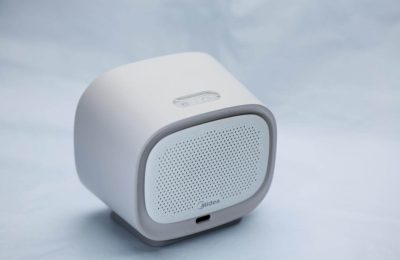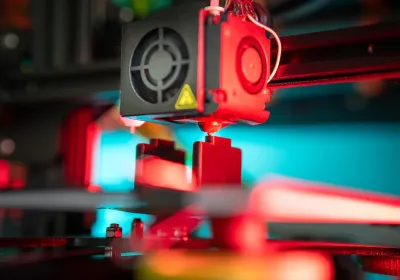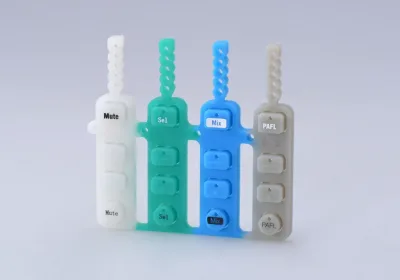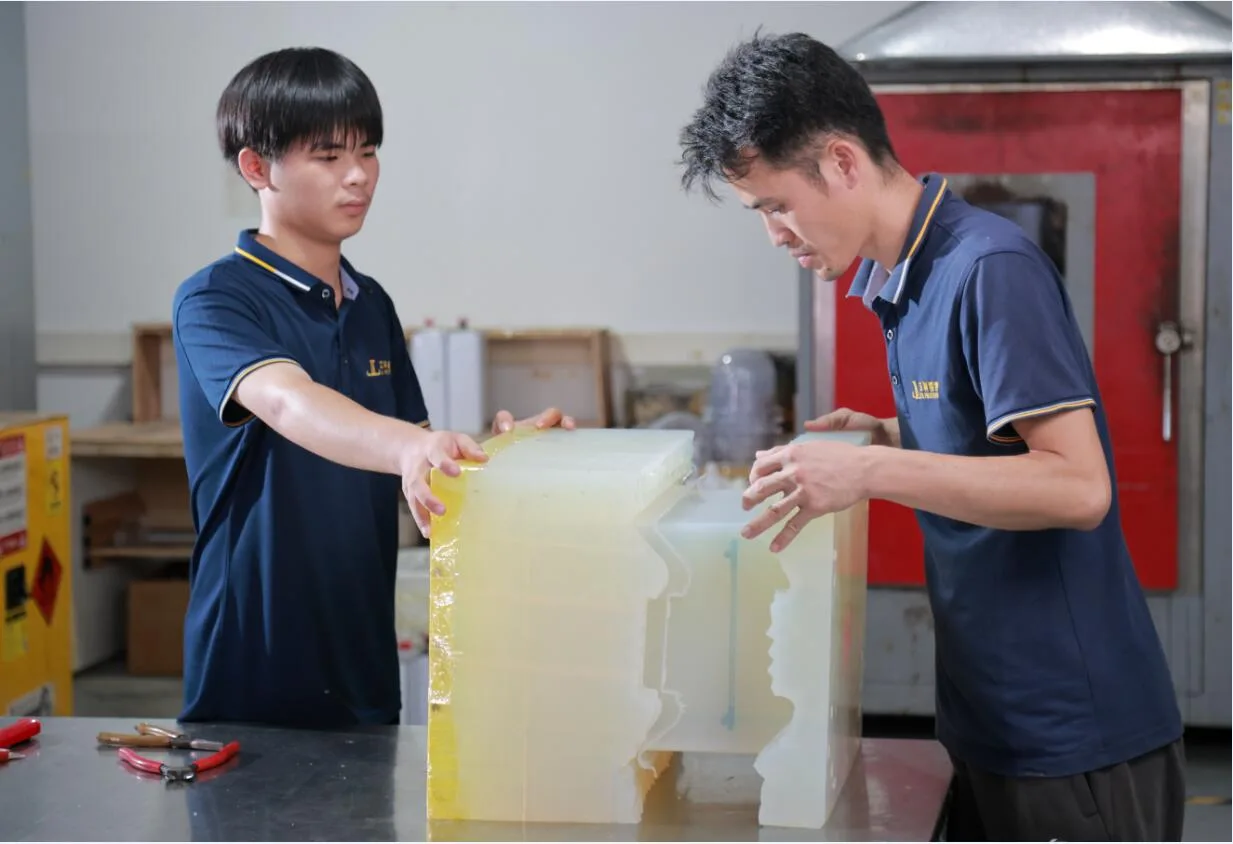
A professional vacuum casting factory uses special machines and careful checks to make good parts for new products. The factory looks at numbers like pressure and temperature to find problems and make more good parts. Machine learning models link how the process works with how many mistakes happen. Digital tracking systems make sure every part follows the rules. The factory uses these ways to help make samples and small batches with good results.
Key Takeaways
A vacuum casting factory has special machines and clean rooms. These help make strong parts with lots of detail and few errors.
The casting process starts with a master model. Workers then make silicone molds. They mix resin and remove air bubbles. Next, they cast the resin using a vacuum. Finally, they finish the parts with care.
CNC machines and 3D printers make master models very exact. This helps the final parts turn out well.
Quality control is very strict. Workers test materials and watch the process with sensors. They measure parts carefully and check finished products closely.
Vacuum pressure casting makes smooth and accurate parts fast. This is great for making prototypes and small groups of parts.
Vacuum Casting Factory Overview
Facility Layout
A vacuum casting factory is set up in a smart way. The main areas are the master model workshop, mold room, casting chamber, and finishing zone. Each area has its own job and helps keep things under control. Workers keep the master model area very clean. This stops dust from messing up the vacuum process. The mold room has tools for mixing and pouring silicone. The casting chamber holds the vacuum equipment. This chamber makes the low-pressure space needed for good parts. In the finishing zone, workers check and polish parts before they are shipped.
Many modern vacuum casting factories are very big. They help make parts for cars and airplanes. These places need parts that are exact and work well. The factories use special systems to watch temperature, pressure, and humidity. This careful checking helps make sure parts fit right and look smooth. The factory’s setup helps make tricky and detailed parts.
Workflow and Safety
The work in a vacuum casting factory follows clear steps. First, workers make a master model. Next, they get the mold ready. Then, they do the casting. Last, they finish the part. Each step happens in its own area to stop dirt from spreading. The vacuum step takes out air bubbles. This makes the parts stronger and look better.
Safety is very important. Workers wear safety gear and follow rules when using chemicals and machines. The factory has alarms and sensors to spot any problems. These tools help stop accidents and keep everyone safe. Workers get training often to learn new safety tips and rules.
Equipment in Vacuum Casting Factory
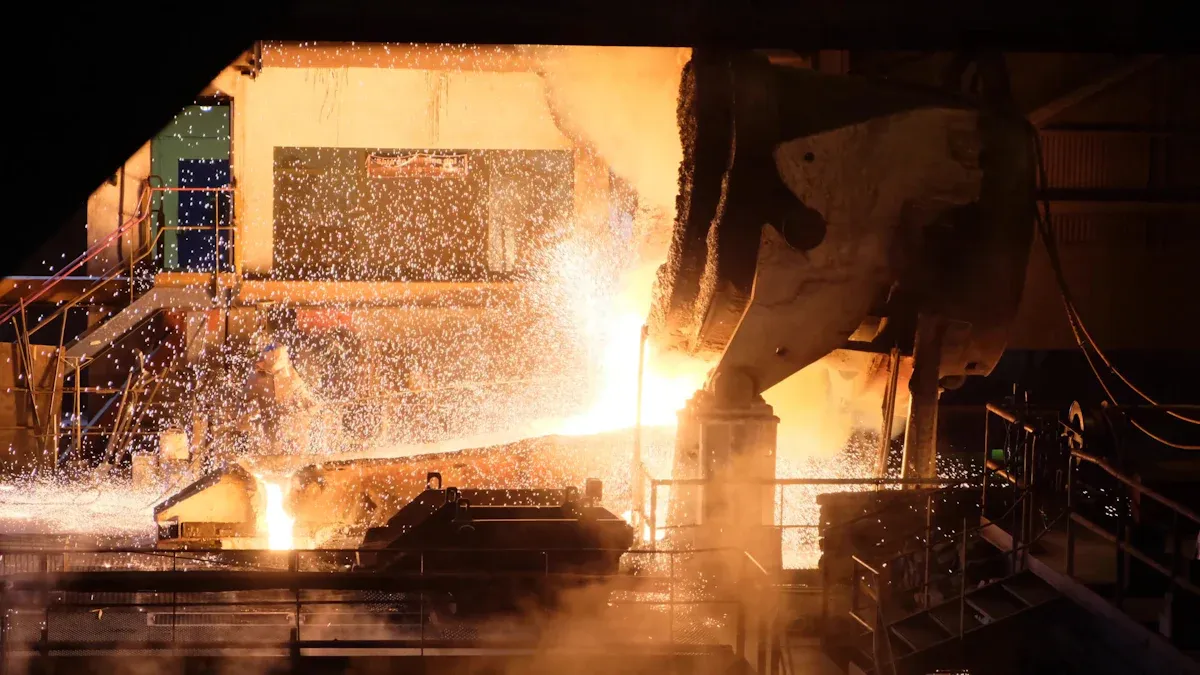
CNC and 3D Printing Tools
A professional vacuum casting factory uses CNC machines and 3D printers to make master models. CNC machines use computers to cut parts from solid blocks. This makes parts that are very exact and smooth. These master models are important for the vacuum pressure casting process. They help make sure every part is the same. CNC machines can make hard shapes and use strong materials. This is good for making prototypes that act like real products.
3D printing helps make the casting process more flexible. FDM, SLA, and SLS are types of 3D printing. They let workers make detailed designs quickly. SLS can make strong prototypes with good strength. 3D printing is fast and lets you try many designs. CNC machining gives the accuracy needed for the vacuum pressure casting machine. Using both tools helps start the casting process with the best master model.
Silicone Mold Equipment
Silicone mold equipment is very important in vacuum pressure casting. Workers use tools to mix and pour silicone around the master model. This makes a soft mold. The mold can make 30 to 50 parts before it breaks down. The casting process uses vacuum pressure to pull out air bubbles from the resin. This makes the parts smooth and free of bubbles. Silicone molds show small details and help make samples and small batches fast.
Note: Silicone molds cost less than metal molds. They work with many resins, like ones that act like rubber, ABS, or PMMA.
Metric | Details |
|---|---|
Mold Lifespan | 20-50 parts per mold |
Surface Finish | Smooth, bubble-free finish |
Dimensional Accuracy | High, due to vacuum degassing |
Cost-effectiveness | Less than half the cost of aluminum molds |
Vacuum Chambers and Pressure Systems
The vacuum pressure casting machine is the main part of the casting process. Factories use vacuum chambers to make a low-pressure space. This step takes out air from the resin and mold. It helps stop mistakes and makes parts stronger. Pressure systems push the resin into every part of the mold. The vacuum pressure casting machine can make small or big parts. It works for many shapes and sizes.
Key things to check for vacuum pressure casting equipment are:
Vacuum levels and pressure ranges
Mold size limits
Resin thickness and mix amounts
Keeping the right temperature
Safety is always important. Workers wear gloves, goggles, and sometimes special masks. They follow rules when using hot or pressurized equipment. The vacuum pressure casting machine helps factories make good, strong parts by controlling each step.
Vacuum Pressure Casting Process

The vacuum pressure casting process has many careful steps. Each step helps make sure the parts are good quality. Every stage builds on the one before it. This makes the final parts meet strict rules. Factories use this process to make samples and small batches. The parts have smooth surfaces and are the right size.
Master Model Creation
The first step is making a master model. Technicians use CNC machines or 3D printers for this. CNC machines cut blocks very accurately. 3D printers build models one layer at a time. Both ways make sure the model matches the digital plan. Factories polish the master model until it is smooth. This is important because the mold copies every detail.
Aspect | Best Practice / Benchmark | Explanation |
|---|---|---|
Master Model Precision | Use CNC machining or 3D printing to create a high precision master model | Ensures dimensional accuracy critical for high-fidelity molds and final parts |
Surface Finish | Polish the surface of the master model | Improves surface quality of molds and final parts |
Tolerance Range | ±0.2mm to ±0.5mm per 100mm of part size | Reflects achievable precision in vacuum casting considering material shrinkage and process factors |
A good master model helps the whole process start well. This step is the base for the rest of the work. It helps keep the parts high quality.
Mold Preparation
After the master model is ready, workers prepare the mold. They pour liquid silicone around the master model. The silicone takes the shape of every detail. Workers use release agents so the part does not stick. Mold design includes lines and angles to help remove the part. Factories control heat, pressure, and time to get the best results.
Mold preparation steps are:
Use release agents for easy part removal.
Make molds thick enough and with the right angles.
Control the casting conditions for better parts.
Fix problems like bubbles or shrinking by changing the mold or using degassing.
Careful mold work helps make fewer mistakes. It also makes the final parts more exact.
Resin Mixing and Degassing
Next, workers mix resin and hardener together. This makes the material for casting. Mixing well is important so the resin is even. Air bubbles can make weak spots or holes. To fix this, workers put the resin in a vacuum chamber. The vacuum pulls out the air bubbles.
Important points for mixing and degassing:
Mix resin well to stop bubbles.
Use vacuum cycles before and after mixing.
Apply vacuum slowly to avoid sudden changes.
Look through the clear lid to check for bubbles.
This step is needed for strong, good parts. Taking out air bubbles makes the parts better.
Casting and Curing
When the mold and resin are ready, casting starts. Workers pour the resin into the silicone mold in a vacuum chamber. The vacuum machine removes leftover air. It helps the resin fill every small space. Pressure systems push resin into tiny grooves.
Higher vacuum helps resin get into small spaces.
Lower heat and vacuum make parts stronger and more stable.
Cooling slowly stops the parts from bending.
This part of the process makes sure each part is the right shape and smooth.
Demolding and Finishing
After the part cures, workers open the mold. They take out the finished part. Workers cut off extra material called flash. Factories check each part by looking and measuring.
Quality Metric / Inspection | Description / Parameter |
|---|---|
Dimensional Tolerance | ±0.1 mm for high-precision parts |
Surface Finish | Ra 0.4-0.8 μm |
Visual Inspection | Performed under at least 500 lux lighting |
Absence of Air Bubbles | Verified through vacuum degassing and controlled curing |
Curing Time | 24 to 72 hours depending on materials |
Finishing can include light cutting, polishing, or painting. These steps make the surface even better. The process ends with a final check. This makes sure every part matches the design and meets the rules.
Tip: Keep equipment clean and check it often. This helps keep the process accurate and the parts high quality.
The vacuum pressure casting process uses special machines and strict checks. This makes parts that are very exact and smooth. Factories use this process to make parts for cars, planes, and hospitals.
Quality Control Standards
Professional vacuum casting factories use strict rules to make sure parts are good. These rules help at every step, from checking materials to looking at finished parts. The goal is to make sure each casting is safe, works well, and meets what customers want.
Material Testing
Material testing is very important in vacuum casting. Technicians follow rules like ASTM F2338 and ISO/IEC 17025 to check materials before starting. These rules help make sure resins, silicones, and additives are pure and work right.
Vacuum decay testing, using ASTM F2338, finds tiny leaks as small as 5 microns. This test does not hurt the parts and keeps them safe.
Groups like the FDA trust vacuum decay testing because it is accurate and can be repeated.
ISO/IEC 17025 certification means labs give results you can trust.
ASTM International rules help make products better and tests more reliable.
Technicians write down every test, what they look for, and what tools they use. This record helps track parts and make the process better over time.
Process Monitoring
Process monitoring helps keep the casting process steady and working well. Factories use sensors and software to watch temperature, vacuum, and timing as it happens. IoT connects machines so everything can be checked together.
Sensors watch temperature, cooling, and vacuum during casting.
Automatic alerts tell workers if something changes, so they can fix it fast.
Software saves old data, which helps find patterns and stop problems.
KPIs, like how many parts are rejected or delivered on time, show how well things are going.
Evaluation Method | Description |
|---|---|
Operator Performance Analysis | Checks skills, training, and mistakes for each worker. |
Mold Design and Maintenance | Looks at molds to keep them strong and parts good. |
Material Handling Analysis | Uses lean ideas to waste less and work faster. |
Quality Control System Analysis | Uses checks and problem-solving to keep quality steady. |
Production Planning & Scheduling | Plans work to save money and time. |
Cost Analysis | Finds ways to spend less money. |
Customer Satisfaction Analysis | Gets feedback to make products better. |
Watching and studying data helps factories change things quickly. This way, they keep making better parts and stop mistakes before they happen.
Dimensional Inspection
Dimensional inspection checks that each casting is the right size and shape. Factories use tools like micrometers, calipers, and CMMs to measure important spots.
Being exact is important in vacuum casting. Tolerances can be as close as ±0.005 inches (0.127 mm) for very precise parts. Rules like ISO 2768 and ASME Y14.5 say what sizes and shapes are okay. Technicians check and adjust tools often to keep them correct.
Tolerance Class | Size Range (mm) | Permissible Deviation (mm) |
|---|---|---|
Fine | 0.5 – 3 | ±0.05 |
Medium | 3 – 6 | ±0.1 |
Coarse | 6 – 30 | ±0.2 |
SPC and MSA help watch for changes and check if measurements are right. These checks make sure parts fit together and meet quality rules.
Final Product Checks
Final product checks make sure every casting is good before it leaves the factory. Inspectors use many tools and ways to see if parts are ready.
Full-size reports check size, threads, thickness, and how parts look.
Appearance checks look at color, texture, and surface.
CMMs measure hard shapes to check size.
Performance tests make sure parts work and fit together.
Material certificates, like RoHS, show materials are safe.
Special tools, like XRF analyzers and optical systems, help with careful checks.
Quality teams use checklists to track how parts work, look, measure, and are packed. These lists show what to check, how many to test, and what tests to use. Sometimes, special tests like strength or weather tests are done on some samples. Factories update these lists often to keep getting better and meet new needs.
Tip: Keeping the workspace clean and tidy helps inspectors find problems fast and make fewer mistakes.
Professional vacuum casting factories follow world rules like ISO and ASTM. They use machines, data, and training to keep quality high. By checking every step, from materials to final checks, these factories make castings that are very exact and dependable.
A professional vacuum casting factory uses special machines and strong rules to make good parts. The vacuum pressure casting process helps parts stay close to the right size, usually within ±0.3% of the plan. Some important tools help keep the casting steady and lower mistakes:
Auxiliary Tool | Contribution to Production Quality and Efficiency |
|---|---|
Advanced Metering Pumps | Measure materials exactly, so parts are always strong and last long. |
Degassing Devices | Take out air bubbles from materials, so parts do not have holes or weak spots. |
Mixing Systems | Help use less material and make cleaning easier, so mixtures stay the same. |
Dynamic Mixing Device | Mix different kinds of materials well, even if they are thick or thin. |
Visual Interface System | Let workers watch and control the process as it happens, so quality stays steady. |
Stories from real factories show that vacuum pressure casting cuts down on bubbles and makes parts more alike each time. If you need to make a sample or a small group of parts fast, picking a vacuum casting factory is a smart choice. You can talk to experts or visit a factory to watch how casting works.
FAQ
What types of products can a vacuum casting factory make?
A vacuum casting factory makes prototypes and small batches. It also makes models for cars, planes, and medical tools. These parts can be housings, covers, or working samples.
How long does the vacuum casting process take?
Most vacuum casting jobs need 7 to 10 days. This time starts with the master model and ends with finished parts. The time can change if the part is tricky or needs more mold work.
Why do factories use silicone molds instead of metal molds?
Silicone molds cost less and are good for making fewer parts. They show small details and let workers change things fast. Metal molds are better for making lots of parts but take more time and money.
How do factories ensure each part meets quality standards?
Factories check every part with careful tests and checks. Workers look at size, surface, and strength. Digital records help track each step and make quality better over time.
 LKprototype
LKprototype

